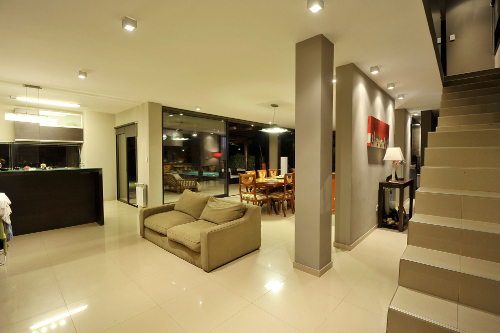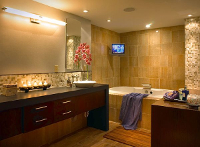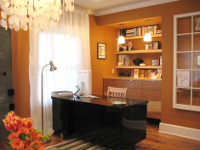 livingrmlightsmallInterior Lighting How Much Lighting is Enough
livingrmlightsmallInterior Lighting How Much Lighting is Enough
One thing in design we can’t live without – good lighting. It’s one of the most important elements in design, and yet most homes are either under-lit or you can use their space as a landing strip for an airplane. We would like to give you some simple ways to figure out not only how much light a room needs but what type of lighting you need.
To start you really need to determine what the room is going to be used for. There are four basic types of lighting which will help you understand how lighting is used. Sometimes you can use more than one type of lighting in a room.
This is considered general lighting. It includes recessed lights, soffit lighting, track lighting, sconces, chandeliers, and pendant lights.
Lighting that is used for specific tasks such as cooking, office or school work, reading, grooming.
This type of lighting should make it easy to see the things you are working on. Some task lighting is in the form of table lamps, pendant lights or under-cabinet lighting.
Accent Lighting
Is used to highlight an object or an area of architectural interest. Accent lighting is usually about three times brighter than ambient lighting.
Natural Light
This is the light that comes from the windows, doors or skylights. It can vary in brightness because of weather and time of day.
The Formula for Lighting a Room
As a general rule, there is a formula to calculate how much light you need in a room:
Room length X Room width x 1.5 = Amount of wattage to light a room
So if you have an 18’ long room x 12’ wide room multiply times 1.5 = 324 watts, that’s how much wattage is needed to adequately light the room. You can divide that lighting into more than one source. 2 Lamps @ 150 watts each and 1 lamp @ 60 watt would be more than adequate light for the room.
Lighting Each Room
Foyer/Entry
Try hanging a Semi-Flush Ceiling Mount or a Chandelier in the foyer. Measure the width and the depth of the foyer and add it together. The diameter of the chandelier should not exceed the sum of the two numbers (10 + 15 = 25) so the Chandelier diameter should not be any wider than 25”. We have given you the formula for figuring the wattage – so don’t forget to calculate it as well. If your foyer is small, try a pendant light, two wall sconces or even two buffet lamps on a side table for an inviting entrance.
Hallway/Stairway
Pendant lighting is a great lighting source in a stairwell. As far as the hallway, there should be a fixture every 8 to 10 feet. The most popular hallway lights are flush or semi -flush ceiling lights. For a different look, try wall sconces that wash the walls with light for a dramatic effect.
Kitchen/Dining Room
Kitchens need bright, general lighting as well as good task lighting. If you are looking at pendants over an island, they should be about 36” above the surface of the island. Just make sure the lights do no hang too close to the cabinet doors, otherwise, you may not be able to open them fully. Let’s say your counter area is 60” long, and you want three pendants divide 60” by 3. So the center pendant should be at 30” then the end pendants should hang at 10” on one end and at 50″ on the opposite end. For food prep try under-counter lighting. It is great task lighting. When you install lights under your counter, make sure that you pull them forward to the front of the cabinet for maximum illumination. If you have a table area or separate dining room, a chandelier (no more than ½ to ¾ the width of the table in diameter (with a maximum of 150 watt lighting capacity) should do the trick. The chandelier should be hung between 30 to 32 inches above the surface of the table. Always install a dimmer switch on high wattage chandeliers and pendants so that you can control the amount of light needed.
 bathlightsmallBath and Vanity Lighting
bathlightsmallBath and Vanity Lighting
Other than the kitchen, excellent lighting is essential for performing personal tasks in the bathroom. Whatever your style, lighting for the bathroom has become a primary part of bath design. The best way to light a vanity is with sconces above the mirror (1, 2, 3 or 4 light sconces are available). You can also mount them on either side of the mirror. A good rule of thumb is to keep the size of the lighting in proportion to the size of the mirrors. Your bath will probably require some form of overhead lighting. For that spa like quality, try a chandelier that coordinates with your vanity lighting. You can also use a ceiling mounted fixture. Think about adding a dimmer switch for those times when you crave that special spa experience. It can really set the mood.
Living Areas – Living Room, Family Room
Most living areas of the house require adequate lighting for reading or other tasks, in addition, some low level, glare-free lights needed for television viewing. To figure out how much lighting you will need in the space, follow this formula :
Room Length x Room Width x 1.5 = Amount of watts needed to light the space
This should help you determine how much lighting you will need in the area. Make sure that you have adequate lighting for reading and other tasks. You can use lamps that have a 3-way switch which will give you a wide range of illumination. Try keeping the lamps proportional to the tables they are sitting on. The bottom of the lampshade should be at eye level when you are seated. Floor lamps are another option when table space is at a minimum. There is usually some form of overhead lighting so try keeping it as a decorative accent and use a dimmer switch so you can change the mood of the room. If all of this seems complicated, a good rule of thumb is to have 4 lighting sources in a room to produce adequate lighting.
 homeofficelightingsmallHome Office
homeofficelightingsmallHome Office
Adequate task lighting is the key to a functional office space. Lamps are the best option to achieve good task lighting. Desk lamps should be about 16” above the work surface to maximize efficiency and reduce glare. If overhead lighting is needed there is recessed lighting or track lighting which will allow you to direct light in the areas that need illumination. It is always a good idea to place overhead lighting on a dimmer to control the brightness, and a home office is no exception.
Bedrooms
Most bedrooms have overhead lighting. When choosing a ceiling fixture, look for something decorative that fits the style of the bedroom. Chandeliers are very popular and look opulent in the bedroom. Don’t be afraid to go for it! Again, make sure whether you choose a chandelier, semi-flush or a flush mount fixture, you install a dimmer switch. It will give you options from bright light all the way to a soft, moody glow. Bedside lighting is also important. It provides you with additional lighting for reading. For maximum illumination, the lamps should be no further than 12 inches away from the side of the bed. Try choosing bedside lamps with three-way switches so you always have the level of light needed for reading, etc. No room for a bedside lamp, try wall mounted sconces. You can purchase either plug in or hard wire versions that look stylish and keep your bedside tables free for that stack of magazines you’ve been wanting to read.
So as you can see, lighting is a critical part of decorating your home. If you choose new lighting, try to be consistent with the style and finish of the lighting. If you love traditional lighting in antique bronze finish, then try to keep all fixtures traditional in style with an antique bronze finish. As with any electrical changes, make sure you have a licensed electrician do the installations. Safety always comes first.
Lighting can truly make or break a space. If you are feeling that your space just isn’t working for you, look at the lighting first. Make sure it is adequate and has the ability to create variable light (dimmers). Not only will it give you the ability to create a welcoming beacon, it can create many different levels of light compatible with your lifestyle. Just knowing the few formulas we gave you can create an environment that is pleasing to your family and your guests. So take a good look at your home, make a few small lighting changes and see what happens!